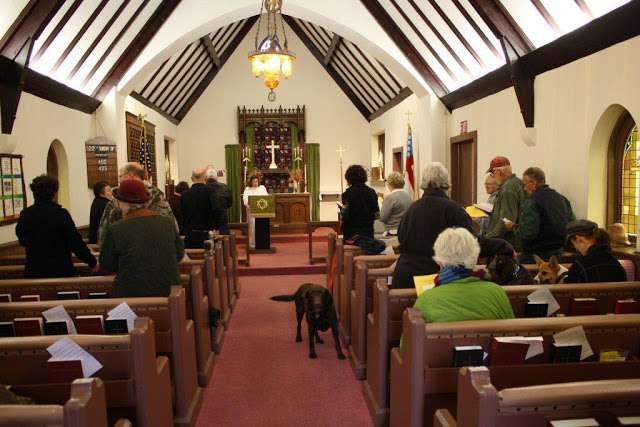St. Jame's Episcopal Church History
Daniel Sylvester Tuttle was the first Episcopal Bishop of the Northwest District, a vast area covering 300,000 square miles and comprising the territories of Montana, Idaho, and Utah. He was Missionary Bishop of Montana with jurisdiction in Idaho and Utah until 1880 when Montana was given a bishop of its own. The Right Reverend Leigh Brewer was Bishop of Montana when it because a Diocese in 1904. Headquartered in Helena, Bishop Brewer traveled to Lewistown once a year for confirmations, baptisms, and other services.
Lewistown had a population then of about 400 people and worship services were held in various homes. About once a month the Reverend H.E. Robbins, Vicar of Fort Benton made the trip by stage coach to conduct worship services.

St. James Guild was in existence two years before we had a church building. It was organized in October of 1897 at the home of Mrs. J.C. Monahan who was elected president. Nine women and Bishop Brewer attended that first meeting. The Guild served suppers at the old Culver Opera House and sponsored bazaars and rummage sales to raise funds to build a church. To their accumulated funds were added generous donations by various individuals.
In the fall of 1899 the corner stone of St. James’ Church was laid. The little group was aided in building the Mission Church by the Missionary District of Montana. Today the deed from the Episcopal Diocese of Montana to St. James’ Church dated 1905 is on file at the Fergus County Courthouse.
In 1899 to 1900, when the church was built, a small rectory was constructed next door, where the Parish Hall now stands. This was the home of the first resident Vicar of St. James’ Mission, the Rev. A.W. Bell, who came in 1900 and was succeeded in 1904 by the Rev. H.G. Wakefield.
The church interior of that day was extremely simple in its furnishings with everything constructed by the carpenters, including the altar and altar rail. No rich carpets or tile covered the six inch wide floor boards, painted like the pews. No padding on the kneelers, the exception being the big green hassocks in the Austin Warr pew. By the back pews was a huge heating stove around which people congregated before going to their pews. A grey stone Baptismal font, located under the hymn board was later used as a bird bath in the front yard of the rectory when a new font was presented in 1913. The light fixtures were of the simplest type and the antique organ needed to be pumped by various young boys, who sometimes forgot to pump, to the distress of the organist. When these boys reached the age where their heads showed at the end of the organ, a new pumper was selected.
Up until 1903 the bell tower had no bell hanging in it so the church requested the “Philippine Bell”. This bell was brought to Lewistown at the end of the Spanish American war from the Philippine Islands by Captain Cheadle and other soldiers of Lewistown’s Company “I” First Montana Infantry. In 1906, the Rev. Bell requested the Lewistown Fire Bell be substituted for the Philippine bell because the first bell was too heavy for the bell tower.
St. James’ became a parish in 1912 and the Rev. Wakefield was succeeded by the Rev. George Hirst who served as the first rector of St. James’ for 26 years.
St. James’ began with a church building with bare stone walls, a desolate yard with no grass and a board sidewalk. During the next 17 years many changes happened to the “Little Stone Church”. It is believed the Rev. Hirst had the vines planted. Some say they came from England. Others suggest a college in the mid-west and claim most of the vines around town came from those original ones.
Years passed and plans to replace the little stone church with a larger one faded. Bishop Faber called this English Gothic style church “a little sanctuary” and to many throughout the years it became and remains precisely that.
The Stones of Saint James
The history of St. James tells that nine leading ladies did a number of things to raise money to build a church. Then as much as possible the church men did the work.
If one looks at the stones it is obvious they were not expensive stones. In fact they used the best ones at the front and sides and the worst ones at the back. However, if one looks at the stones for the hall, they are quite different. They are well cut and beautiful. This is the story told to me by an elderly parishioner.
If one drives between Lewistown and Grass Range there can be seen an old railroad grade. The company went broke and it was never finished. I have been told the tunnels are there and for some time the timbers for the trestles were stored there. When the railroad went broke the project was abandoned.
The priest of St. James at the time asked for the stones that had been used to pack down the dirt and rocks for the railroad. Someone gave him those stones and they built the Parish Hall. If the railroad had not been abandoned, those stones would have been used to make a very nice depot in Lewistown.
The St. James parishioners planned to turn the large hall into the main church and keep the little church for a chapel. If one looks at the windows they are the proper shape for a church. They only lack stained glass. There are some large windows of stained glass in the front of the building. There is a small upper room and before they lowered the ceiling there had been a way to open for the choir and perhaps for the organ.